Geography - Blog Posts

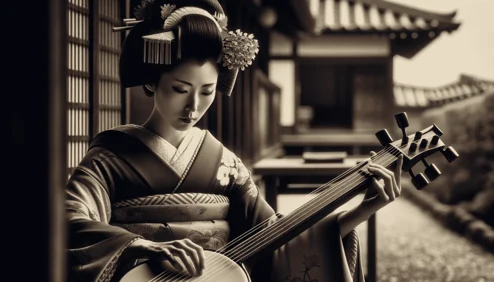





Hace unos meses, ha tenido lugar en el país del sol naciente en uno de los distritos más populares de Kyoto, por el que transcurren las geishas a pesar de los avisos que se han hecho respecto al tema, como: El no hacer fotos o vídeos, la gente ha pesado de los avisos que se han hecho. - Parece ser que hay personas que se lo han pasado por donde les ha dado la gana hay gente que ha llegado a tirarle de la ropa, además de perseguirlas cuando se iban a meter en el taxi y un largo etcétera a día de hoy desde este pasado mes de abril, pues, no se puede entrar a no ser que entres y pagues una multa lo cual me parece bien y también me parece bien como sistema para controlar el exceso de turismo. - ¿Qué opinan ustedes? Os leo en comentarios. - A few months ago, it took place in the land of the rising sun in one of the most popular districts of Kyoto, where geishas hang out despite the warnings that have been made regarding the subject, such as: Do not take photos or videos , people have weighed the warnings that have been made. - It seems that there are people who have had it wherever they wanted, there are people who have even pulled at their clothes, in addition to chasing them when they were about to get into the taxi and a long etcetera to this day from this past month of April, well, you cannot enter unless you enter and pay a fine, which seems fine to me and also seems fine to me as a system to control excess tourism. - What do you think? I read you in comments. - 数カ月前、日出ずる国の京都で、芸者衆が通る人気の繁華街で、こんなことがあった: 写真やビデオを撮らないよう、人々は警告を重く見た。 - 昨年4月の今日から、入場して罰金を払わない限り入場できないようになったが、これはこれでいいような気もするし、過剰な観光を抑制するシステムとしてもいいような気もする。 - どう思いますか?どう思いますか?
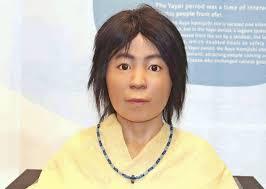




Sean bienvenidos amantes del mundo japonés a una nueva publicación, en este caso voy a dar mi opinión sobre uno de los hallazgos que se han hecho en el país del sol naciente y que tiene que ver con el rostro del niño reconstruido y de cómo la genética se aplica a la arqueología espero que os guste.
-
Antes que nada, el periodo yayoi abarca las siguientes fechas, 300a. C 300 d.C estas fechas son las tradicionales, aunque hay estudios más recientes del siglo IX antes de Cristo desde la península de Kyūshū, pero bueno, eso serán otras publicaciones que realizaré sobre el tema, pero en este caso nos vamos a centrar en este hallazgo este hombre se llama Aoya kamijiro.
-
Fue creado en octubre de 2021, ya que 1998 se encontraron unos restos arqueológicos de más de cien huesos humanos por lo cual es una tarea complicada, pero que nos permite reconstruir las facciones y no solo de la gente prehistórica, sino también de la propia historia como del mundo antiguo y de muchas épocas históricas.
-
Esto se obtiene a raíz de los huesos de los que se pueden extraer pequeñas muestras que son las que nos permitirán, saber si el individuo en cuestión era masculino era femenino y si padecía patologías.
-
Las nuevas tecnologías nos permitirán reconstruir fiel miente de alguna forma u otra el rostro, a la cual parece, ya que esto es un avance muy notable, tanto en la genética como en la arqueología porque podemos reconstruir bastante bien a la gente del pasado no sobre toda la población, que suele estar olvida en un segundo plano.
-
Espero que os haya gustado que pasen una buena semana.
-
日本を愛する皆さん、新しい出版物へようこそ。今回は、日出ずる国で行われた、復元された子供の顔と遺伝学に関係する発見の 1 つについて、私の意見を述べたいと思います。考古学にも応用できると思います。
-
まず、弥生時代は以下の300aの年代になります。 西暦 300 年頃 これらの日付は伝統的なものですが、九州半島からは紀元前 9 世紀に関するより最近の研究もありますが、それはまた別の出版物でこのテーマについて行う予定ですが、この場合は次のようにします。この発見に焦点を当ててください この男の名前は青谷神代です。
-
1998年に100体以上の人骨の考古学的遺跡が発見されて以来、この計画は2021年10月に作成された。そのため複雑な作業ではあるが、先史時代の人々の派閥だけでなく、古代世界や歴史上のさまざまな時代からの歴史そのものです。
-
これは骨から得られるもので、少量のサンプルを抽出することで、問題の人物が男性か女性か、また病状を患っていたかどうかを知ることができます。
-
新しいテクノロジーにより、何らかの方法で、その顔に見える顔を忠実に復元できるようになります。これは、遺伝学と考古学の両方において非常に注目に値する進歩です。なぜなら、私たちは過去の人々についてではなく、非常によく復元できるからです。国民全体が、通常は背景に隠れて忘れ去られています。
-
気に入っていただければ幸いです。良い一週間をお過ごしください。
-
Welcome lovers of the Japanese world to a new publication, in this case I am going to give my opinion on one of the discoveries that have been made in the country of the rising sun and that has to do with the reconstructed child's face and how genetics It applies to archeology. I hope you like it.
-
First of all, the yayoi period covers the following dates, 300a. C 300 AD These dates are the traditional ones, although there are more recent studies from the 9th century BC from the Kyūshū peninsula, but well, that will be other publications that I will make on the subject, but in this case we are going to focus on this discovery This man's name is Aoya kamijiro.
-
It was created in October 2021, since archaeological remains of more than one hundred human bones were found in 1998, which is why it is a complicated task, but it allows us to reconstruct the factions and not only of the prehistoric people, but also of history itself. as from the ancient world and from many historical periods.
-
This is obtained from the bones from which small samples can be extracted that will allow us to know if the individual in question was male or female and if he suffered from pathologies.
-
New technologies will allow us to faithfully reconstruct the face, in some way or another, to which it appears, since this is a very notable advance, both in genetics and in archeology because we can reconstruct quite well the people of the past not about the entire population, which is usually forgotten in the background.
-
I hope you liked it and have a good week.

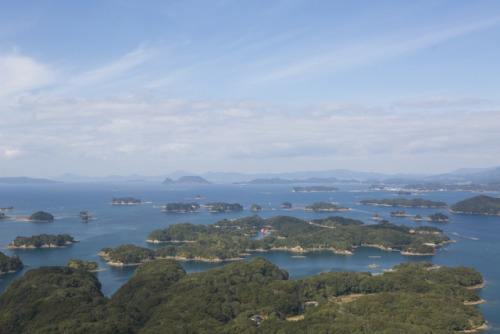
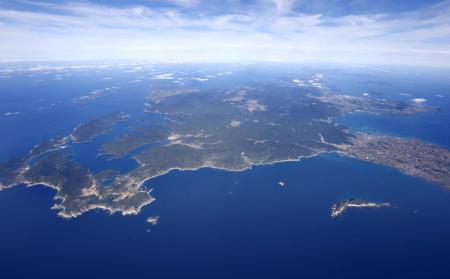

Sean bienvenidos japonistaarqueológicos, a una nueva actualidad del país del sol naciente. En este caso os comentaré que se han actualizado los datos del número de islas del archipiélago Japonés, dicho esto pónganse cómodos que empezamos. - La información viene de la agencia Geoespacial de Japón, el número de islas son de 14125 en todo el país, más del doble del número anunciado hasta ahora, en 1987 el cálculo era de 6852 islas. - El número de islas en cada prefectura Nagasaki 1479 Hokkaido 1473 Kagoshima 1256 Iwate 861 Okinawa 691. - ¿Qué opinan al respecto? Espero que tengan una buena semana y nos vemos en próximas publicaciones de Japón - 日出づる国から新しいニュースへようこそ。今回は、日本列島の島の数が更新されたことをお伝えします。 - 国土地理院からの情報ですが、日本全国の島の数は14125で、今まで発表されていた数(1987年は6852島)の2倍以上になっています。 - 各都道府県の島嶼数 長崎県 1479 北海道 1473 鹿児島県 1256 岩手県 861 沖縄県 691 - いかがでしょうか?今週も良い一週間をお過ごしください。また、今後の日本からの投稿でお会いしましょう。 - Welcome to a new update from the land of the rising sun. In this case I will tell you that we have updated the data on the number of islands in the Japanese archipelago, so make yourselves comfortable and let's get started. - The information comes from the Geospatial agency of Japan, the number of islands is 14125 in the whole country, more than double the number announced until now, in 1987 the estimate was 6852 islands. - The number of islands in each prefecture Nagasaki 1479 Hokkaido 1473 Kagoshima 1256 Iwate 861 Okinawa 691. - What do you think about it? I hope you have a good week and see you in future posts from Japan.
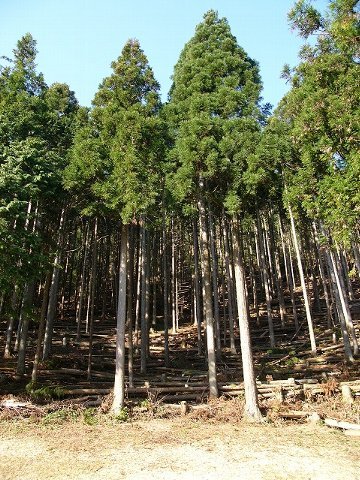





Sean bienvenidos japonistasarqueológicos a una nueva entrega en esta ocasión os hablaré sobre Cryptomeria japonica (スギ), más popularmente conocido como el cedro japonés, una vez dicho esto pónganse cómodos que empezamos. - Se localizan al sur de Hokkaido (ほっかいどう) el cedro es el árbol más alto de Japón, y los árboles más altos superan los 50 m. Además son los árboles más longevos de Japón,hay árboles que tienen entre 2000 y 3000 años en todo Japón. - Espero que os guste ¿lo conocían? os deseo una feliz semana y nos vemos en próximas publicaciones del país del sol naciente. - 今回は、杉の木(Cryptomeria japonica, スギ)についてのお話です。 - 北海道の南に位置するスギは、日本で最も高い木で、高い木は50mを超えます。また、日本で最も長寿の木でもあり、日本各地に樹齢2000年から3000年の木があるそうです。 - それでは、今週も一週間、どうぞよろしくお願いいたします。 - Welcome japonistasarqueológicos to a new installment in this occasion I will talk about Cryptomeria japonica (スギ), more popularly known as the Japanese cedar, having said that, make yourselves comfortable and let's get started. - Located south of Hokkaido (ほっかいどう) the cedar is the tallest tree in Japan, with the tallest trees exceeding 50m. They are also the longest-lived trees in Japan,there are trees that are between 2000 and 3000 years old all over Japan. - I hope you like it, did you know it? I wish you a happy week and see you in future publications from the land of the rising sun.




Sean bienvenidos japonistasarqueologicos a una nueva entrega del país del sol naciente en la que os explicaré que es el tsuyu, una vez dicho esto pónganse cómodos que empezamos. - ¿Qué es el tsuyu? ¿En qué consiste? El tsuyu, en hiragana つゆ y en kanji corresponde a 梅雨. Esto corresponde a los meses de verano en Japón: Mayo a julio seguramente todos habréis visto la película de Tenki no ko, del director Makoto shinkai, en el que se puede apreciar muy bien este fenómeno por poner un ejemplo. En estos dos meses caen grandes trombas de agua a raudales que para algunos le resultará placentero y otros una tortura¿Qué es para vosotros?, ¿os gustan los periodos de lluvia? - Espero que os haya gustado y nos vemos en próximas publicaciones que pasen una linda semana. - 日本の考古学者諸君、ようこそ、日出ずる国の新連載へ。ツユとは何かを説明しよう。 - ツユとは何か?つゆとは、ひらがなでは「つゆ」、漢字では「梅雨」にあたる。皆さんは新海誠監督の映画『天 気の子』をご覧になったことがあるだろう。この2ヶ月間、滔々と降り注ぐ大雨は、ある人にとっては喜びであり、ある人にとっては拷問である。 あなたは雨の時期が好きですか? - それでは、また次の記事でお会いしましょう。 - Welcome, Japanese archaeologists, to a new installment of the land of the rising sun in which I will explain to you what the tsuyu is, having said that, make yourselves comfortable and let's get started. - What is tsuyu and what does it consist of? Tsuyu, in hiragana つゆ and in kanji it would correspond to 梅雨. This corresponds to the summer months in Japan: May to July, you have probably all seen the film Tenki no ko, by director Makoto Shinkai, in which this phenomenon can be seen very well, to give an example. In these two months, huge downpours of water fall in torrents, which for some people will be a pleasure and for others a torture. What is it like for you, do you like periods of rain? - I hope you liked it and see you in the next posts have a nice week.


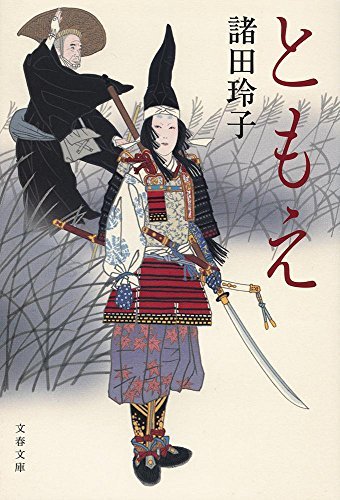



Sean bienvenidos, japonistasarqueológicos a una nueva entrega en esta ocasión hablaremos de Tomoe Gozen una vez dicho esto pónganse cómodos que empezamos. - Tomoe Gozen en hiragana (ともえごぜん) pertenece a Onna-bugeisha (女武芸者) mujeres luchadoras en japonés se conoce más como Ba Yuqian, al hablar de samurais se nos viene imágenes de hombres, las mujeres también tuvieron un gran papel y Tomoe Gozen fue una mujer que participó en el conflicto Genpei 1180-1192, su existencia está un tanto discutida. - Kiso Yoshinaka es muy hábil en las artes marciales y es bueno en el uso de arcos y flechas, os pondré una foto de la Estatua de Kiso Yoshinaka y Bagomae en la prefectura de Nagano. Fue una gran estratega, ya que cuenta la leyenda que en la Batalla del paso de Kuligara uso toros de fuego. - El Cantar de Heike: Son los poemas clásicos más importantes de la historia y la literatura japonesa, en el cual hablan de un sinfín de personajes y leyendas de la época. Fue escrito a principios del siglo XIII. - Espero que os haya gustado, os deseo una feliz semana y nos vemos en próximas publicaciones. 考古学ジャポニストの皆さん、新しい連載へようこそ。今回は巴御前についてお話します。そうは言っても、気を楽にしてから始めましょう。 - ひらがなで「ともえごぜん」は女武芸者に属し、日本語では巴玉銭として知られる女性戦士です。武士といえば男性のイメージが思い浮かびますが、女性も大きな役割を果たしました。 1180年から1192年にかけて源平合戦に参加した女性ですが、その存在については若干の議論があります。 - 木曽義仲は武芸に優れ、弓矢の扱いにも長けており、長野県にある木曽義仲像と馬籠前の写真を載せておきます。 クリガラ峠の戦いでは火の雄牛を使用したという伝説があるため、彼女は優れた戦略家でした。 - 平家の歌: 平家の歌は、日本の歴史と文学において最も重要な古典詩であり、その中で当時の無数の登場人物や伝説について語られています。 13世紀初頭に書かれました。 - 気に入っていただけたなら幸いです。楽しい一週間をお過ごしください。また今後の出版物でお会いしましょう。 Welcome, Archaeological Japonists to a new installment, this time we will talk about Tomoe Gozen, having said that, make yourself comfortable and let's start. - Tomoe Gozen in hiragana (ともえごぜん) belongs to Onna-bugeisha (女武芸者) female fighters in Japanese is better known as Ba Yuqian, when talking about samurai images of men come to mind, women also had a great role and Tomoe Gozen was a woman who participated in the Genpei conflict 1180-1192, her existence is somewhat disputed. - Kiso Yoshinaka is very skilled in martial arts and is good at using bows and arrows, I will put you a photo of Kiso Yoshinaka Statue and Bagomae in Nagano Prefecture. She was a great strategist, since she tells the legend that in the Battle of Kuligara Pass she used bulls of fire. - The Song of Heike: They are the most important classical poems in Japanese history and literature, in which they speak of an endless number of characters and legends of the time. It was written at the beginning of the 13th century. - I hope you liked it, I wish you a happy week and see you in future publications.

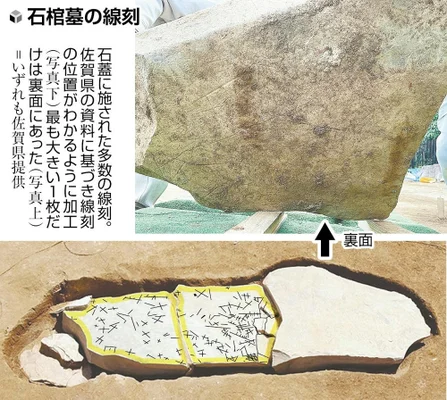



Sean bienvenidos, japonistasarqueológicos, a una nueva entrega de arqueología nipona, una vez dicho esto pónganse cómodos qué empezamos. - Nos volvemos a trasladar a la prehistoria japonesa que, cada día, nos sorprende con un nuevo hallazgo arqueológico. Las ruinas de Yoshinogari, datan del periodo Yayoi, pero en este caso del Yayoi tardio y se localizan en la prefectura de saga. - Se trata de una tumba de unos dos metros de largo¿Quién estaba enterrado en ella? Futuras investigaciones arrojarán luz. ¿Qué opinan ustedes sobre este hallazgo? - Os deseo una feliz semana y nos vemos en próximas publicaciones. 日本の考古学者たちよ、ようこそ!それでは、くつろいでいただき、始めましょう。 - 毎日、新しい考古学的発見で私たちを驚かせてくれる日本の先史時代へと話を戻します。吉野ヶ里遺跡は、佐賀県にある弥生時代後期の遺跡です。 - 古墳の長さは約2メートル。 誰が埋葬されていたのだろうか。この発見は、今後の研究によって明らかにされるでしょう。 あなたはどう思われますか? - それでは、今週もよろしくお願いします。また、今後の記事でお会いしましょう。 - Welcome, Japanese archaeologists, to a new instalment of Japanese archaeology, so make yourselves comfortable and let's get started. - We move back to Japanese prehistory, which surprises us every day with a new archaeological find. The ruins of Yoshinogari, dating back to the Yayoi period, but in this case to the late Yayoi period, are located in the prefecture of Saga. - The tomb is about two metres long. Who was buried in it? Further research will shed light on this discovery. What do you think about it? - I wish you a happy week and see you in future posts.

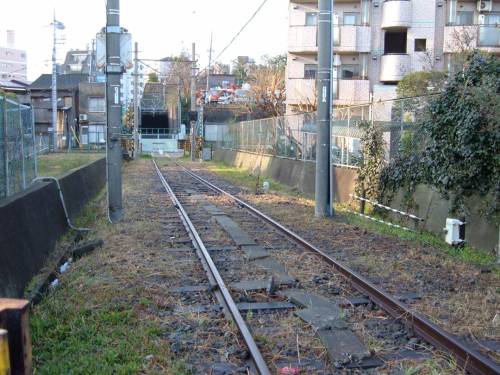

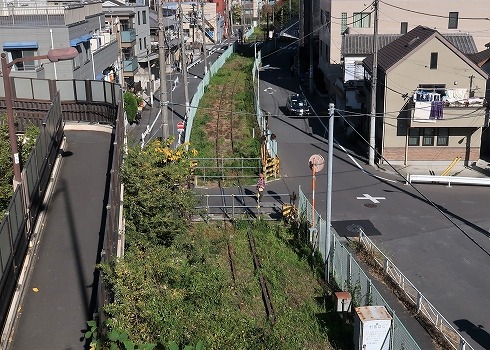

Sean bienvenidos a un Japón distinto del que muchos turistas pasan de largo por las grandes ciudades turísticas. — Espero que os guste y nos vemos en próximas publicaciones, que pasen una buena semana. - 観光都市で多くの観光客が通り過ぎる日本とは異なる日本へようこそ。 - 今後の記事でお会いできることを楽しみにしています。 - Welcome to a different Japan from the one that many tourists pass by in the big tourist cities. - I hope you like it and see you in future posts, have a nice week.


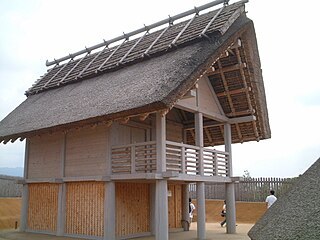



Sean bienvenidos, japonistasarqueológicos, a una nueva entrega de arqueología nipona, una vez dicho esto pónganse cómodos qué empezamos. - Nos volvemos a trasladar a la prehistoria japonesa que, cada día, nos sorprende con un nuevo hallazgo arqueológico. Las ruinas de Yoshinogari, datan del periodo Yayoi(III-IV) pero en este caso del Yayoi tardío y se localizan en la prefectura de Saga¿Cuándo llegó el arroz a japón? Y¿por dónde llegó? Hay dos teorías: una que llegó de china y la otra desde Corea hasta la isla de Kyushu a través del mar de Ariake. El enorme asentamiento está rodeado por tres fosos y es la raíz de los castillos en Japón, ha sido seleccionado como uno de los 100 castillos más famosos de Japón. - En el periodo Yayoi, se caracteriza porque es cuando aparecen las clases guerras y las clases dirigentes a raíz de la acumulación de poder, esto corresponde a los jefes locales, por ejemplo: La residencia de la clase dominante en el recinto interior sur, no confundir con realeza japonesa, hay que recordar que a los poblados se les instalaba un punto religioso, por aquella época predominaba el Sintoismo como: es el caso del santuario principal construido en el recinto interior norte. - El yacimiento cuenta con atalaya del recinto interior sur, de carácter defectivo, al sur se encuentra el pueblo con viviendas tipo foso y almacenes para guardar el arroz rojo que era el que se cultivaba en aquella época y en la ciudad de Karatsu, también en la prefectura de Saga, se encuentran las ruinas de Nabatake, las ruinas de cultivo de arroz más antiguas de Japón. - Durante el periodo Yayoi y Kofun tuvieron lugar una serie de migraciones desde la península de corea, esto trajo consigo que las poblaciones coreanas y japonesas de la zona se mezclaran generando mestizos, además de transmitir sus conocimientos de la agricultura. - Espero que os haya gustado y nos vemos en próximas publicaciones, que pasen una buena semana. Welcome, Japanese archaeologists, to a new instalment of Japanese archaeology, so make yourselves comfortable and let's get started. - We move back to Japanese prehistory, which surprises us every day with a new archaeological find. The ruins of Yoshinogari, dating from the Yayoi period (III-IV) but in this case from the late Yayoi period, are located in the prefecture of Saga When did rice arrive in Japan? And where did it arrive? There are two theories: one that it came from China and the other from Korea to the island of Kyushu via the Ariake Sea. The huge settlement is surrounded by three moats and is the root of castles in Japan, it has been selected as one of the 100 most famous castles in Japan. - The Yayoi period is characterised by the emergence of the warring and ruling classes as a result of the accumulation of power, this corresponds to the local chiefs, for example: The residence of the ruling class in the southern inner precinct, not to be confused with Japanese royalty, it should be remembered that the villages had a religious point installed, at that time Shintoism predominated, such as the main shrine built in the northern inner precinct. - The site has a watchtower in the southern inner enclosure, which is defective, to the south is the village with moat-like dwellings and warehouses for storing the red rice that was cultivated at the time, and in the town of Karatsu, also in Saga Prefecture, are the ruins of Nabatake, the oldest rice cultivation ruins in Japan. - During the Yayoi and Kofun period a series of migrations from the Korean peninsula took place, which resulted in the mixing of the Korean and Japanese populations in the area and the passing on of their knowledge of agriculture. - I hope you liked it and see you in future posts, have a good week.



Parte 1: Sean bienvenidos, japonistasarqueológicos, a una nueva entrega, en esta ocasión hablamos del inglés en Japón, una vez dicho esto pónganse cómodos qué empezamos. - ¿Por qué en Japón el inglés es un idioma, no es muy hablado por los japoneses? En Japón el 2% de los Japoneses hablan japonés de 125.507.000 personas, lo cual toparse con japoneses que hablen inglés es una tarea difícil, el Español, es un idioma más popular en Japón, además a los japoneses les encanta la cultura Española. - A pesar de que hablar con japonés en inglés es difícil principalmente porque les cuesta entender la pronunciación, por esa razón el katakana haya palabras en inglés pronunciadas malamente. - Espero que os guste y nos vemos en próximas publicaciones, que pasen una buena semana.
第1回 日本の考古学者の皆さん、新しい回へようこそ。今回は日本における英語についてです。 - なぜ日本では、英語は日本人にあまり話されていない言語なのでしょうか? 日本では、1億2,550万7,000人の人口のうち、日本語を話す日本人は2%で、英語を話す日本人に会うのは難しい。 - 日本人と英語で話すのは難しいが、それは日本人が発音を理解するのが難しいからである。
- 今後の記事でお会いできることを楽しみにしています。
Welcome, Japanesearchaeologicalists, to a new installment, this time we are talking about English in Japan, having said that, get comfortable and let's start.
-
Why is English a language in Japan, not widely spoken by the Japanese? In Japan, 2% of the Japanese speak Japanese out of 125,507,000 people, which means that finding Japanese people who speak English is a difficult task. Spanish is a more popular language in Japan, and Japanese people love Spanish culture.
-
Although speaking with Japanese in English is difficult mainly because it is difficult for them to understand the pronunciation, for that reason the katakana there are English words pronounced poorly. -
I hope you like it and see you in future posts, have a good week.


権力者の冠をデザイン? 天皇陵出土説もある謎の石枕の正体に迫る.
Designing the crown of a powerful person? Uncovering the true nature of the mysterious stone pillow that is said to have been excavated from the Emperor's tomb.




Sean bienvenidos, japonistasarqueologicos a una nueva entrega en la que hablaremos sobre el asunto de Japón y las aguas residuales al mar una vez dicho esto pongan cómodos que empezamos. - Hace poco están en todos los medios de comunicación del mundo, que Japón tiene luz verde por la ONU para verter agua tratada en la planta nuclear de Fukushima en el accidente acontecido en 2011. - Hay más de 1.000 tanques y 1,34 millones de toneladas, posiblemente al 98% de la capacidad, además se está analizando el agua de mar y los alrededores de la central nuclear, actualmente se está analizando la concentración de tritio, los resultados estarán disponibles el día 25 por la tarde, previamente se habían tomado muestras de agua de los depósitos dando como resultado que era seguro, pero posiblemente tendrían que haber esperado más tiempo. - La población japonesa, se manifiesta al respecto porque esto va a generar problemas a largo plazo a la economía mundial. China suspende todas las importaciones de productos del mar japoneses, no se iba a quedar de brazos cruzados ¿Qué opinan ustedes al respecto? - Espero que os haya gustado y nos vemos en próximas publicaciones que pasen una buena semana.
考古学の日本研究者の皆様、ようこそ!今回は、日本と海への汚水問題についてお話しします。
最近、日本が2011年の福島原発事故の処理水を海洋投棄することを国連から許可されたことが世界中のメディアを賑わせている。
タンクは1000基以上、134万トンあり、おそらく容量の98%であろう。また、海水と原発周辺は分析中で、現在はトリチウムの濃度が分析されており、25日の午後に結果が出る予定である。以前は貯水池から水を採取し、安全であるという結果を出していたが、おそらくもっと待つべきだったのだろう。
日本国民が抗議しているのは、これが世界経済に長期的な問題を引き起こすからである。中国が日本産水産物の輸入を全面的に停止したのだから、黙って見過ごすわけがない。 これについてどう思う?
お気に召していただけたなら幸いである。 それではまた、良い一週間を。
Welcome, japonistasarqueologicos to a new installment in which we will talk about the issue of Japan and sewage into the sea, that said, make yourselves comfortable and let's get started. - It has recently been all over the world's media that Japan has been given the green light by the UN to dump treated water into the Fukushima nuclear power plant from the 2011 accident. - There are more than 1,000 tanks and 1.34 million tons, possibly at 98% of capacity, also the sea water and the surroundings of the nuclear plant are being analysed, currently the concentration of tritium is being analysed, the results will be available on the 25th in the afternoon, previously water samples had been taken from the reservoirs giving as a result that it was safe, but possibly they should have waited longer. - The Japanese people are protesting because this is going to create long-term problems for the world economy. China suspends all imports of Japanese seafood, they are not going to sit back and do nothing. What do you think about this? - I hope you liked it and I'll see you in future posts. Have a good week.

Sean bienvenidos, japonistasarqueológicos al yacimiento arqueológico del toro, os presento a los dos últimos, estudiantes de la arqueología de posguerra, al final haré una pequeña conclusión personal, una vez dicho esto pónganse cómodos que empezamos. - Yoshie inaba Nacida en 1932 ¿Qué aportaciones hizo en el yacimiento? Anotó todos los datos que pudo, eso facilitó mucho las futuras investigaciones, además ayudó a la gente para que no fueran muy cargadas. Os pondré una foto del Uniforme de escuela secundaria Fuji - Girls. Sr. Wan Kikawa:Nacido en 1928, le contrató uno de ingeniería civil, en lo que es ahora Hinamigo, Prefectura de Nagasaki. Él encontró los siguientes objetos: dos brazaletes de cobre superpuestos y una espada de madera, que os pondré a continuación. - Conclusión personal: Estimada audiencia, no solo veáis a los yacimientos solo por los restos, también hay personas que ayudan a preservar los restos para próximas generaciones, además si no fueran por estas personas mencionadas, anteriormente seguramente sus aportaciones al yacimiento y a la historia de Japón no hubieran facilitado las cosas todos tenemos que poner nuestro grano de arena para crear la historia humana del pasado y del futuro. Además en aquella época dada persona con lo poco tenía aportan lo que podrían al yacimiento, sobre todo los agricultores de las cercanías, por ejemplo, las dificultades son la que hacen que prosperen las cosas. Espero que os haya gustado y nos vemos en próximas publicaciones que pasen una buena semana. 日本の考古学者の皆さん、エル・トロ遺跡へようこそ。戦後考古学の学生の皆さん、最後のお二人に私は最後に小さな個人的な結論を述べます。そうは言っても、気を楽にしてから始めましょう。 - Yoshie inaba 1932 年生まれ 彼女はこのサイトにどのような貢献をしましたか? 彼はできる限りすべてのデータを書き留めたので、今後の調査がはるかに容易になり、人々が過度の負担にならないようにも助けられました。 富士高校の制服の写真を載せます - 女の子たち。 木川湾氏:1928年生まれ、現在の長崎県日並郷で土木技師に就職。 彼は次の物体を発見しました: 2 つの重なり合った銅製のブレスレットと 1 つの木の剣です。これらを以下に示します。 - 個人的な結論: 親愛なる聴衆の皆さん、遺跡の現場を訪れるだけでなく、後世のために遺跡を保存するのに協力する人々もいます。もし上記の人々がいなかったら、遺跡と歴史への彼らの貢献は間違いなくあります。私たちは皆、過去と未来の人類の歴史を創造するために自分の役割を果たさなければなりません。 さらに、当時は、ある人がなけなしの努力で現場、特に近隣の農家にできる限りの貢献をし、困難こそが繁栄を生むのです。 気に入っていただければ幸いです。今後の投稿でお会いしましょう。良い一週間をお過ごしください。
Welcome, Japanesearchaeologicalists to the archaeological site of El Toro, I present to you the last two, students of post-war archaeology, at the end I will make a small personal conclusion, having said that, make yourself comfortable and let's begin.
Yoshie inaba Born in 1932 What contributions did she make to the site? She wrote down all the data she could, which made future investigations much easier, and also helped people so that they were not burdened too much. I will post a photo of the Fuji High School Uniform
Girls. Mr. Wan Kikawa: Born in 1928, he hired him as a civil engineer, in what is now Hinamigo, Nagasaki Prefecture. He found the following objects: two overlapping copper bracelets and a wooden sword, which I will show you below. - Personal conclusion: Dear audience, do not only see the sites for the remains, there are also people who help preserve the remains for future generations, and if it were not for these people mentioned above, surely their contributions to the site and the history of Japan They would not have made things easier. We all have to do our part to create the human history of the past and the future. Furthermore, at that time, a given person with what little they had contributed what they could to the site, especially the nearby farmers, for example, difficulties are what make things prosper.
I hope you liked it and see you in future posts, have a good week.
for more information/詳細については:https://www.shizuoka-toromuseum.jp/toro-site/people/people-intervew01/


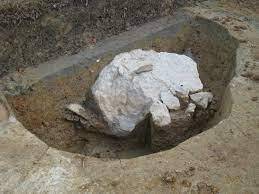

Sean bienvenidos japonistasarqueologicos, a una nueva entrega de arqueología nipona en esta ocasión nos vamos a la prefectura de Hyogo, que se localiza en la región de Kansai con su capital Kobe una vez dicho esto pónganse cómodos que empezamos. - Hyogo estaba atravesada por cuatro caminos: Sanin-do en al norte, Sanyo-do en el centro, Nankai-do en el sur y Mimasaka-do y Tajima-do, recordamos que do en japonés es camino. A lo largo de los caminos, tienden a colocarse las casas, ya que son vías de comunicación y comercio que iban a dos ciudades, entre otras, como son el caso de la Station House ciudad de Tatsuno y Noma Station House ciudad de Kamigori. - En la primera foto os enseño las excavaciones arqueológicas realizadas en las campañas de: 2007-2009(Ruinas de Furu-Ouchi la casa de la estación de Kako: Noguchi-cho, ciudad de Kakogawa). En la segunda foto os enseño las excavaciones arqueológicas realizadas en las campañas de: 2010-2012(Ruinas de Nagasaka-dera nombre provisional: Casa de la estación Omi: Uozumi-cho, ciudad de Akashi). En la tercera foto os enseño las excavaciones arqueológicas realizadas en las campañas de: 2013-2016(Ruinas de Mukoyama Estación de Ouchi <Oichi>: Taiichi Naka, ciudad de Himeji). En la cuarta y última foto os enseño las excavaciones arqueológicas realizadas en las campañas de:2017-2022(Ruinas de Tsujigauchi Takada Station House: Kamigori Town). - Espero que os guste y nos vemos en próximas publicaciones fotos fuente:hyogo_koukohaku les doy mis más sinceras felicitaciones por el gran trabajo que ejecutan para la historia de la humanidad. Welcome Japanese archaeologists, to a new installment of Japanese archaeology, this time we are going to Hyogo prefecture, which is located in the Kansai region with its capital Kobe, so make yourselves comfortable and let's get started. - Hyogo was crossed by four roads: Sanin-do in the north, Sanyo-do in the centre, Nankai-do in the south and Mimasaka-do and Tajima-do, remember that do is Japanese for road. Along the roads, houses tend to be placed, as they are communication and trade routes that went to two cities, among others, such as the Station House in Tatsuno city and Noma Station House in Kamigori city. - In the first photo I show you the archaeological excavations carried out in the campaigns of: 2007-2009 (Ruins of Furu-Ouchi the Kako Station House: Noguchi-cho, Kakogawa City). In the second photo I show you the archaeological excavations carried out in the campaigns of: 2010-2012(Ruins of Nagasaka-dera provisional name: Omi station house: Uozumi-cho, Akashi city). In the third photo I show you the archaeological excavations carried out in the campaigns of: 2013-2016(Ruins of Mukoyama Ouchi Station <Oichi>: Taiichi Naka, Himeji city). In the fourth and last photo I show you the archaeological excavations carried out in the campaigns of:2017-2022(Ruins of Tsujigauchi Takada Station House: Kamigori Town). - I hope you like it and see you in future publications photos source:hyogo_koukohaku I give you my sincere congratulations for the great work you execute for the history of mankind.
日本の考古学者の皆さん、ようこそ日本考古学の新連載へ。今回は関西地方に位置し、県庁所在地の神戸を擁する兵庫県です。 - 兵庫県には4つの道があった:北の山陰道、中央の山陽道、南の南海道、そして美作道と但馬道である。たつの市の駅舎や上郡市の野間駅舎のように、街道沿いには家が建ち並ぶ。 - 1枚目の写真は、2007年から2009年にかけて行われた発掘調査(加古川市野口町・古大内駅舎跡)。 写真2枚目は、2010年〜2012年の発掘調査(長坂寺跡(仮称)近江駅舎跡:明石市魚住町)。 3枚目は2013年〜2016年の発掘調査(姫路市太一中:向山大内駅跡)です。 最後の4枚目は、2017年から2022年にかけての発掘調査(辻垣内高田駅舎跡:上郡町)です。 - あなたがこの写真を気に入ってくださり、今後の出版物でお会いできることを願っています。 photo source:hyogo_koukohaku あなたが人類の歴史のために行っている偉大な仕事に対して、心から祝福を贈ります。





Sean bienvenidos, japonistasarqueológicos, a una nueva entrega arqueológica en esta ocasión hablaremos de un túmulo funerario con forma de ojo de cerradura una vez dicho esto pónganse cómodos que empezamos. - El túmulo se localiza en la ciudad de Yokohama, en la prefectura de Kanagawa, en la región de Kantō, isla de Honshū. Se realizaron excavaciones en las Ruinas de Oikawa Isemiya que acompañan la construcción de la carretera de circunvalación de la Ruta Nacional 246 Atsugi Hadano Road. El túmulo funerario tiene forma de ojo de cerradura, data de alrededor de los siglos III al VII d.c y fue descubierto en la cuenca del río Ogino. - El túmulo funerario, con forma de ojo de cerradura, tiene unas dimensiones de 37 metros de largo y 21 metros de ancho. En el sitio se encontraron una losa y herramientas de piedra del período Kofun. En los alrededores se han encontrado los restos de una vivienda del período Jomon. - Espero que os haya gustado y nos vemos en próximas publicaciones que pasen una buena semana. Welcome, Japanese archaeologists, to a new archaeological instalment, this time we are going to talk about a burial mound in the shape of a keyhole, so make yourselves comfortable and let's get started. - The burial mound is located in the city of Yokohama, Kanagawa Prefecture, in the Kantō region of Honshū Island. Excavations were conducted at the Oikawa Isemiya Ruins accompanying the construction of the Atsugi Hadano Road 246 National Route 246 bypass. The burial mound is keyhole-shaped, dates from around the 3rd to 7th centuries AD, and was discovered in the Ogino River basin. - The burial mound, shaped like a keyhole, is 37 metres long and 21 metres wide. A stone slab and stone tools from the Kofun period were found at the site. The remains of a Jomon period dwelling were found nearby. - I hope you liked it and I will see you in future publications. Have a nice week. 日本の考古学者の皆さん、ようこそ考古学の新連載へ!今回は鍵穴の形をした古墳についてお話しします。 - 古墳は神奈川県横浜市、本州の関東地方にある。国道246号厚木秦野道路バイパスの建設に伴い、及川伊勢宮遺跡で発掘調査が行われた。荻野川流域で発見されたこの古墳は、紀元後3世紀から7世紀ごろのもので、鍵穴のような形をしている。 - 鍵穴のような形をした古墳は、長さ37メートル、幅21メートル。古墳時代の石板や石器が出土している。近くに縄文時代の住居跡が見つかった。 - お気に召していただけたなら幸いである。 それでは、よい一週間を。 -




Sean bienvenidos japonistasarqueologicos a una nueva entrega del país del sol naciente en la que os, hablaré del Santuario Arashihiban, una vez dicho esto pónganse cómodos que empezamos. - El santuario Arashihiban, se localiza en la prefectura de Miyagi al noreste de Japón, en la isla de Honshu. Aragshinkan ¿A qué dios está dedicado? Es un dios que está envuelto en muchos misterios, además, es adorado en las regiones de Tohoku y Kanto. Arashiben-jinja se localiza en la ciudad de Tagajo y se desconoce la fecha exacta de cuando se construyó, pero consta en los registros del año 1774. - ¿En qué consiste el Tsugarusoto Sangunshi? Se trata de un antiguo documento, que fue descubierto por Kihachiro Wada. Sin embargo, ahora se podría tratar de una falsificación, Arahabaki aparece más el nombre de una familia que gobernó la región de Tsugaru(correspondería a los terratenientes europeos en Japón se les conoce como daimyō, en hiragana みょう). Dejen en los comentarios vuestra opinión, para debatirlo. - Espero que os haya gustado y nos vemos en próximas publicaciones que pasen una linda semana. Welcome Japanese archaeologists to a new installment from the land of the rising sun in which I will talk about the Arashihiban Shrine, so once you have said that, make yourselves comfortable and let's get started. - Arashihiban Shrine is located in Miyagi Prefecture in northeastern Japan, on the island of Honshu. Aragshinkan Which god is it dedicated to? It is a god that is shrouded in mystery and is worshipped in the Tohoku and Kanto regions. Arashiben-jinja is located in the city of Tagajo and the exact date of its construction is unknown, but it is recorded as being built in 1774. - What is the Tsugarusoto Sangunshi? It is an ancient document, which was discovered by Kihachiro Wada. However, it could now be a forgery, Arahabaki appears more the name of a family that ruled the Tsugaru region (corresponding to European landowners in Japan are known as daimyō, in hiragana みょう). Leave in the comments your opinion, for discussion. - I hope you liked it and see you in future posts have a nice week.
日本の考古学者の皆さん、日出ずる国からの新しい回にようこそ!今回は嵐播神社についてお話しします。 - 嵐播神社は宮城県にある。荒神館 どの神様を祀っているのですか?謎に包まれた神で、東北地方と関東地方で信仰されている。荒祭神社は多賀城市にあり、正確な創建年代は不明だが、1774年に創建されたと記録されている。 - 津軽外三郡誌とは?和田喜八郎によって発見された古文書である。しかし、現在では偽書である可能性もあり、アラハバキはむしろ津軽地方を支配していた一族の名前に見える。議論のために、あなたの意見をコメントに残してください。 - それではまた、良い一週間をお過ごしください。



Sean bienvenidos japonsistasarqueológicos, a una nueva publicación en esta ocasión nos trasladamos a prefectura de Akita una vez más para hablar de la tumba de Ono no Komachi una vez dicho esto comenzamos. - Fue famosa como poeta, si no también tenía una belleza incomparable: ¡Fui a cubrir la tumba de Ono no Komachi en la ciudad de Osaki! ! La ciudad de Osaki, fue donde se refugió tras, ser expulsada del mismo, tuvo que regresar a Akita su ciudad natal. Después de eso, realizó una visita de 100 días para orar por la recuperación de su enfermedad, pero falleció el día en que se cumplió su deseo. Se dice que cuando los aldeanos la vieron, se apiadaron de ella y erigieron una lápida por su triste muerte. - ¿Quién fue Ono no Komachi? Fue una poetisa del periodo Heian, se desconocen cuando nació y murió, pero se la conoce como "Rokukasen", se baraja la posibilidad de que viviera en Kioto, además de la prefectura de Akita, como la prefectura de Kioto y la prefectura de Kumamoto, sobre dónde se dice que nació. - Espero que os haya gustado y nos vemos en próximas publicaciones, ¿Conocían esta historia y a la poetisa?. 今回も秋田県に場所を移し、小野小町の墓についてお話しします。 - 歌人として有名な小野小町だが、その美しさは比類ない。大崎市にある小野小町の墓を取材した!!大崎市から追放された彼女が避難した大崎市は、故郷の秋田に帰ることになった。その後、病気の回復を祈願して百日詣りをしたが、その願いが叶った日に亡くなった。その姿を見た村人たちが憐れみ、悲しい死を悼んで墓石を建てたという。 - 小野小町とは?平安時代の歌人で、いつ生まれ、いつ亡くなったかは不明だが、「六歌仙」の名で知られ、京都のほか、秋田県、京都府、熊本県などに住んでいたと考えられている。 - この物語と歌人をご存知でしたか? Welcome to a new publication, this time we move to Akita prefecture once again to talk about the tomb of Ono no Komachi, so let's begin. - She was famous as a poet, but she also had an incomparable beauty: I went to cover the tomb of Ono no Komachi in the city of Osaki! ! Osaki City, where she took refuge after being expelled from Osaki, had to return to Akita, her hometown. After that, she made a 100-day visit to pray for recovery from her illness, but died on the day her wish came true. It is said that when the villagers saw her, they took pity on her and erected a tombstone for her sad death. - Who was Ono no Komachi? She was a poetess of the Heian period, it is unknown when she was born and when she died, but she is known as "Rokukasen", and it is thought that she lived in Kyoto, as well as Akita Prefecture, Kyoto Prefecture and Kumamoto Prefecture, where she is said to have been born. - I hope you liked it and see you in future posts. Did you know this story and the poetess?

Sean bienvenidos, japonistasarqueologos, a una nueva entrega en esta ocasión comentaremos de por qué en Japón se come poca carne, una vez dicho esto pónganse cómodos que empezamos. - Seguramente todos pensemos, que en Japón se come carne y no otro tipo de alimentos, ya que eso sería un estereotipo alimenticio. Para empezar el tema hay que entender que la geografía juega un papel muy importante en todo esto porque hay pocos focos donde los japoneses puedan tener el ganado, por el hecho de que su país es muy accidentado geográficamente hablando, el 90% de la carne es importada como otros muchos productos porque Japón escasean muchos de ellos. - En su territorio crían pollos y la Wagyu que es la más conocida y más cara del mundo, además, Japón es el segundo mayor importador de carne de cerdo del mundo, llegando a importar unas 923.835 toneladas de carne en 2020. Por eso comer carne en Japón es muy cara, hay platos con carne, pero no os creáis que hay muchos, al contrario de los que hay más son de: pescado, arroz, verduras, es decir los brotes de soja, el arroz les sale más barato por poner algunos ejemplos y los lácteos es otro de los productos que son muy caros. Su dieta es una de las más sanas del mundo y eso se ve en su población la más longeva del mundo, llegando a los 100 años, aparte de un gran equilibrio alimenticio, aplicado a una buena filosofía. - En esta publicación no he hablado de la influencia Yankee en Japón, pero qué país no tiene su influencia de su asquerosa comida chatarra, normal que sean el país con más problemas de obesidad del mundo. Espero que os haya gustado y nos vemos en próximas publicaciones que pasen una buena semana. - ジャポニスタ・サルケオロゴスの皆さん、ようこそ!今回は、なぜ日本では肉をあまり食べないのかについてコメントします。 - 日本では肉を食べ、他の種類の食べ物は食べない。というのも、日本の国土は地理的に非常に起伏に富んでいるため、日本人が家畜を飼うことができる場所はほとんどない。 - さらに、日本は世界第2位の豚肉輸入国であり、2020年には約92万3,835トンの肉を輸入する。そのため、日本で肉を食べるのは非常に高価である。肉を使った料理はあるが、その数はそれほど多くない。彼らの食生活は世界で最も健康的なもののひとつであり、そのことは、優れた哲学に基づいた栄養バランスの良さとは別に、世界で最も長寿で100歳に達する彼らの人口にも表れている。 - 本書では、日本におけるヤンキーの影響については触れなかったが、ジャンクフードの影響を受けていない国があるだろうか?それでは、また次の記事でお会いしましょう。 - Welcome, japonistasarqueologos, to a new installment in this occasion we will comment on why in Japan they eat little meat, having said that, make yourselves comfortable and let's get started. - Surely we all think that in Japan they eat meat and not other types of food, since that would be a food stereotype. To begin the subject we must understand that geography plays a very important role in all this because there are few places where the Japanese can keep livestock, due to the fact that their country is very rugged geographically speaking, 90% of the meat is imported like many other products because Japan has a shortage of many of them. - On its territory they raise chickens and Wagyu which is the best known and most expensive in the world, in addition, Japan is the second largest importer of pork in the world, importing some 923,835 tonnes of meat in 2020. That is why eating meat in Japan is very expensive, there are dishes with meat, but do not think that there are many, on the contrary there are more: fish, rice, vegetables, i.e. bean sprouts, rice is cheaper to give some examples and dairy products is another of the products that are very expensive. Their diet is one of the healthiest in the world and this can be seen in their population, the longest in the world, reaching 100 years of age, apart from a great nutritional balance, applied to a good philosophy. - In this publication I have not talked about the Yankee influence in Japan, but what country does not have its influence of its disgusting junk food, it is normal that they are the country with more obesity problems in the world. I hope you liked it and see you in the next posts have a nice week.




Sean bienvenidos, japonistasarqueologicos, al segundo capítulo del japón prehistórico y seguir recorriendo sus lugares mitológicos y mágicos una vez dicho esto póngase comandos que empezamos. - Para continuar nuestro viaje, más vale tarde que nunca pero despacio y con buena letra. Nos trasladamos a Kuromatayama una montaña con forma de pirámide, que se localiza en la meseta de Nakadori en el distrito Towada Oyu de la ciudad de Kazuno , prefectura de Akita. - En la década de 1992,se realizó una encuesta académica y como resultado, aunque esta montaña actualmente está cubierta de tierra, se descubrió que era una estructura artificial de unos 7 a 10 niveles que llegaban desde la base hasta la cima. Además, se halló una cavidad a 10 metros por debajo de la cumbre, y es muy probable que alguien esté enterrado allí. - Espero que os haya gustado y nos vemos en próximas publicaciones mis amantes del mundo japonés, que pasen una buena semana. - 考古学者の日本主義者の皆さん、先史時代の日本の第 2 章へようこそ。神話と魔法の場所を旅し続けてください。そう言われたら、コマンドを入力して始めましょう。 - 旅を続けるには、遅刻しないよりはマシですが、ゆっくりと良い字で書きましょう。 秋田県鹿角市十和田大湯地区の中通高原にあるピラミッド型の山「黒俣山」へ移動します。 - 1992年代に学術調査が行われた結果、この山は現在は土で覆われているものの、麓から頂上まで7~10層程度の人工構造物であることが判明した。 また、山頂から10メートルほど下には空洞が発見されており、人が埋葬されている可能性が高い。 - 日本の世界を愛する皆さん、良い一週間をお過ごしください。 - Welcome, archaeological Japanists, to the second chapter of prehistoric Japan and continue touring its mythological and magical places. Once that has been said, put in commands and let's begin. - To continue our journey, better late than never but slowly and with good handwriting. We move to Kuromatayama, a pyramid-shaped mountain, located on the Nakadori Plateau in the Towada Oyu district of the city of Kazuno, Akita Prefecture. - In the 1992s, an academic survey was conducted and as a result, although this mountain is currently covered with earth, it was found to be an artificial structure of about 7 to 10 levels reaching from the base to the top. Additionally, a cavity was found 10 meters below the summit, and it is very likely that someone is buried there. - I hope you liked it and see you in future posts my lovers of the Japanese world, have a good week.




Sean bienvenidos, japonistasarqueológicos, a una nueva entrega de arqueología nipona, una vez dicho esto pónganse cómodos qué empezamos. — En la publicación anterior estuvimos hablando de las ruinas de Yoshinogari, que datan del período Yayoi (300-250) pero en este caso del Yayoi tardío y se localizan en la prefectura de Saga. Esta vez vamos a profundizar un poco más en dicho yacimiento. En la década de 1928-1986 y hasta el presente se han estado hallando restos arqueológicos nuevos. Pero las excavaciones y las investigaciones empezaron en 1928, esta fecha corresponde a la era taisho, también se realizaron excavaciones en Fukuoka la prefectura vecina, principalmente ligados a dos temas, la agricultura y la innovación industrial. En la prefectura de saga, se encontraron vasijas del periodo Yayoi, hasta del periodo Nara, hay que entender que el lugar ha podido ser utilizado en periodos históricos simultáneos, desde la prehistoria hasta nuestros días, como ya mencionamos anteriormente, el yacimiento se localiza cerca del mar de Ariake. A 3 kilómetros nos encontramos las ruinas de Mitsunagata, que estaría cerca de la puerta del parque arqueológico. - En la década de los años 50, se desentierran en las zonas de cultivos, ataúdes de tinajas. En 1928 aparecen: brazaletes de conchas y cuencos de vidrio. Pero no será hasta la década de los años 70 cuando se hacen excavaciones a gran escala, inclusive prospecciones, al noreste de Yoshinogari en las que se encontraron, espejos de bronce y armas de hierro. Se hallaron restos de edificios que se creen que son almacenes de piso elevado. 1980-1982, se excavó arroz carbonizado, esto nos permitirá saber cuál era la dieta y la procedencia del mismo. En 1986, por motivos industriales y por el canal de agua en la prefectura de Saga que comunica el río Chikugo, hasta el río Kase, esto desentierra restos de fosos y huecos de postes de madera. — Espero que os haya gustado y nos vemos en próximas publicaciones, que pasen una buena semana. - 日本の考古学者の皆さん、日本の考古学の新しい記事へようこそ。そうは言っても、気を楽にして始めましょう。 — 前回は、弥生時代(300~250年)、今回は弥生後期、佐賀県にある吉野ケ里遺跡についてお話しました。 今回はこの預金についてもう少し詳しく掘り下げていきます。 1928 年から 1986 年の 10 年間と現在に至るまでに、新しい考古学的遺跡が発見されています。 しかし、発掘調査が始まったのは大正時代にあたる1928年で、隣県の福岡でも主に農業と産業革新という2つのテーマに沿った発掘調査が行われました。 佐賀県では弥生時代から奈良時代の器物が出土しており、先史時代から現代に至るまでの同時期に使われていた可能性があることは、前述したとおりです。有明海の近く。 3キロほど離れたところに、遺跡公園のゲート付近にある三長田遺跡がある。 - 50年代の10年間に、栽培地域で壺の棺が発掘されました。 1928年に貝殻のブレスレットとガラスのボウルが登場しました。 しかし、吉野ヶ里の北東で測量を含む大規模な発掘が行われ、青銅鏡や鉄製の武器が発見されるのは70年代の10年になってからである。 高層倉庫とみられる建物跡が見つかった。 1980年から1982年にかけて焦げた米が発掘され、その食性や起源を知ることができます。 1986年、産業上の理由と、筑後川から嘉瀬川につながる佐賀県の水路の堀と木の柱穴の遺跡が発掘されました。 — 気に入っていただければ幸いです。今後の出版物でお会いしましょう。良い一週間をお過ごしください
Welcome, Japanese archaeologists, to a new installment of Japanese archaeology, having said that, make yourself comfortable and let's start. — In the previous post we were talking about the Yoshinogari ruins, which date from the Yayoi period (300-250) but in this case from the late Yayoi and are located in the Saga prefecture. This time we are going to delve a little deeper into said deposit. In the decade of 1928-1986 and up to the present, new archaeological remains have been found. But the excavations and investigations began in 1928, this date corresponds to the Taisho era, excavations were also carried out in Fukuoka the neighboring prefecture, mainly linked to two themes, agriculture and industrial innovation. In the prefecture of saga, vessels from the Yayoi period to the Nara period were found, it must be understood that the place could have been used in simultaneous historical periods, from prehistory to the present day, as we mentioned above, the site is located near of the Ariake Sea. 3 kilometers away we find the ruins of Mitsunagata, which would be near the gate of the archaeological park. - In the decade of the 50s, coffins of jars were unearthed in the cultivation areas. In 1928 they appear: shell bracelets and glass bowls. But it will not be until the decade of the 70s when large-scale excavations, including surveys, are made northeast of Yoshinogari in which bronze mirrors and iron weapons were found. Remains of buildings believed to be high-floor warehouses were found. 1980-1982, charred rice was excavated, this will allow us to know its diet and origin. In 1986, for industrial reasons and for the water channel in Saga Prefecture that connects the Chikugo River, to the Kase River, this unearths remains of moats and wooden post holes. — I hope you liked it and see you in future publications, have a good week.




Sean bienvenidos, japonistasarqueologicos, al tercer capítulo del Japón prehistórico y seguir recorriendo sus lugares mitológicos y mágicos, una vez dicho esto póngase comandos que empezamos. - Para continuar nuestro viaje, más vale tarde que nunca, pero despacio y con buena letra. Nos trasladamos al yacimiento arqueológico de Sannai Maruyama en la prefectura de Aomori, localizada en la región de Tōhoku. - La estructura, de madera, data del periodo jomon, es una estructura que funcionó como un gran calendario, ya que algo común que tienen todas las culturas en el mundo es adorar a las estrellas en lo que respecta a la prehistoria. El yacimiento data del 3900 a.c localizado a lo largo del río Okidate en la punta de una suave colina que se extiende desde las montañas Hakkoda. - En la década de 1992, tuvieron lugar las excavaciones que han desenterrado los restos de viviendas en pozos, tumbas de adultos, niños y los pozos de almacenamiento, entre otros rastros de la vida cotidiana. Además de una hay una gran cantidad de herramientas de loza de piedra. Se han excavado una gran variedad de huesos de pescado y de animales que indican hábitos alimenticios de aquella gente, también fueron encontrados frutos secos: como castañas y nueces. Además, se han desenterrado muchas reliquias orgánicas, como productos de madera, herramientas de hueso, canastas tejidas, así como artículos comerciales como jade, obsidiana de áreas remotas y asfalto. Hay una teoría: en Iwate se crean estructuras similares para realizar la danza de los ciervos ¿Qué opinan al respecto? _ Espero que os haya gustado y nos vemos en próximas publicaciones mis amantes del mundo japonés, que pasen una buena semana. - 考古学者の日本主義者の皆さん、先史時代の日本の第 3 章へようこそ、神話と魔法の場所を旅し続けてください。 - 旅を続けるには、遅刻しないよりはマシですが、ゆっくりと上手な字で。 東北地方にある青森県の三内丸山遺跡へ移動します。 - この木造建造物は縄文時代にまで遡り、先史時代から世界のどの文化にも共通して星を崇拝しており、偉大な暦として機能していた建造物です。 この遺跡は、八甲田山系から続くなだらかな丘陵の先端、沖館川沿いに位置し、紀元前 3900 年に遡ります。 - 1992 年代に発掘調査が行われ、井戸内の住居跡、大人、子供の墓、貯蔵穴、その他の日常生活の痕跡が発掘されました。 1 つ以外にも多数の石器の道具があります。 当時の人々の食生活を示す魚や動物の骨が多数出土しており、栗やクルミなどの木の実も出土しています。 さらに、木製品、骨道具、編んだかごなどの有機遺物や、翡翠、辺境の黒曜石、アスファルトなどの交易品も発掘されています。 岩手でも鹿踊りをするために同じような建物が作られているという説がありますが、どう思いますか? _ 日本の世界を愛する皆さん、良い一週間をお過ごしください。 - Welcome, archaeological Japanists, to the third chapter of prehistoric Japan and continue touring its mythological and magical places. Having said that, put yourself in command and let's begin. - To continue our journey, better late than never, but slowly and with good handwriting. We move to the Sannai Maruyama archaeological site in Aomori prefecture, located in the Tōhoku region. - The wooden structure dates back to the Jomon period, it is a structure that functioned as a great calendar, since something common that all cultures in the world have is worshiping the stars in regards to prehistory. The site dates back to 3900 BC located along the Okidate River at the tip of a gentle hill that extends from the Hakkoda Mountains. - In the 1992s, excavations took place that unearthed the remains of dwellings in wells, graves of adults, children and storage pits, among other traces of daily life. In addition to one there are a large number of stoneware tools. A wide variety of fish and animal bones have been excavated that indicate the eating habits of those people. Nuts such as chestnuts and walnuts were also found. In addition, many organic relics have been unearthed, such as wooden products, bone tools, woven baskets, as well as trade items such as jade, obsidian from remote areas, and asphalt. There is a theory: in Iwate similar structures are created to perform the deer dance. What do you think about it? _ I hope you liked it and see you in future posts my lovers of the Japanese world, have a good week.

日本の考古学と科学思想の歴史。
第2章 :
日本の考古学者の皆さん、哲学的観点から見た新しい日本考古学へようこそ。 — 前の章で、特定のトピック、歴史、考古学、人類学について質問されるとき、たとえば「私たちの先祖は誰ですか?」とコメントしました。 そして彼らはどうやって X 場所にたどり着いたのでしょうか? 考古学自体が 19 世紀末の 1877 年に登場したとき、1884 年に人類学研究所が、1895 年に日本考古学協会が誕生したことについて触れます。 - 19 世紀の人なら、「私は誰ですか、どこから来たのですか?」と尋ねるでしょう。 ドイツ語、中国語、ノルウェー語、日本語などを尋ねることができます。 この種の質問は今日に至るまで答えられていません。 歴史学と考古学はそれらに答えを与えておらず、今日の他の分野でさえさらに多くのことを知っていますが、道のりはまだ長いです。 19世紀の日本、特にその終わり頃は、自分たちの起源を知りませんでした。 1980 年代の日本の科学者なら誰でも、最初の日本人入植者は誰だったのか疑問に思うでしょう。 ここに定住するきっかけは何ですか? 現在、最初の入植者は約 3 万年前に到着したことが知られていますが、彼らだけだったのでしょうか? この諸島には、海面が現在より 120 倍も低かったため、中国と朝鮮の半島を北と南から通ってやって来た最初の入植者がいたことが知られています。 日本人は非常に古い本を 2 冊持っていることが知られており、1 冊は西暦 711 年、もう 1 冊は西暦 722 年のものです。 最初の書紀は古事記と呼ばれ、二番目の日本書紀は、神 (カミスと呼ばれる) による西暦 660 年からの日本の建国について語っています。この日本の神聖な起源の概念は、第二次世界大戦 (第二次世界大戦) まで続きます。 これら 2 冊の本は、ヨーロッパではギリシャとローマに遡る最古の本に相当します。 - 気に入っていただければ幸いです。今後の投稿でお会いしましょう。良い一週間をお過ごしください。
HISTORY OF JAPANESE ARCHEOLOGY AND SCIENTIFIC THOUGHT.
Episode 2:
Welcome, Japanesearchaeologicalists, to a new installment of Japanese archaeology, seen from a philosophical point of view. Having said that, get comfortable and let's begin.
—
In the previous chapter, we commented that when we are asked questions about certain topics, history, archeology and anthropology, for example: Who were our ancestors? And how did they get to X place? We mention, when archeology itself emerged at the end of the 19th century, 1877, the origin of the anthropology laboratory in 1884 and in 1895 the Japanese archeology society.
-
A person from the 19th century would ask: Who am I, where do I come from? We could ask a: German, Chinese, Norwegian, Japanese, etc. These types of questions remain unanswered to this day. History and archeology have not given them an answer, even other disciplines today know much more, but there is still a long way to go. Japan during the 19th century, especially the end of that period, did not know its own origin. Any Japanese scientist in the 1980s would wonder who were the first Japanese settlers? What led you to settle here? Currently, it is known that the first settlers arrived about 30,000 years ago. Were they the only ones? It is known that the archipelago was inhabited by other inhabitants who were the first settlers. They arrived through the peninsula of China and Korea, both from the north and the south, since the sea level was 120 times lower than today. It is known that the Japanese have two very old books, one dates from 711 and the other from 722 AD. The first is called Kojiki and the second Nihonshoki, the Kojiki tells of the founding of Japan from the year 660 AD by the gods (called kamis), this concept of the divine origin of Japan would last until World War II (2ww). These two books would be the equivalent in Europe of the oldest dating back to Greece and Rome.
-
I hope you liked it and see you in future posts, have a good week.

HISTORIA DE LA ARQUEOLOGÍA JAPONESA Y EL PENSAMIENTO CIENTÍFICO.
Capítulo 1: Sean bienvenidos, japonistasarqueológicos, a una nueva entrega de arqueología nipona, vista desde un punto de vista filosófico, una vez dicho esto pónganse cómodos qué empezamos. — Seguramente, todos nos hacemos las mismas preguntas cuando se nos pregunta determinados temas de historia y de arqueología. ¿Quiénes eran nuestros antepasados y por qué llegaron a este determinado lugar y no a x? ¿De qué medios disponían para lograr determinadas hazañas históricas? En nuestro caso nos centraremos en dos preguntas determinadas ¿Quiénes fueron los primeros pobladores del archipiélago japonés? Y de ver cómo dicha idea ha llegado a nuestros días sin una respuesta clara, ya que tanto arqueólogos, historiadores, antropólogos, entre otros, han intentado dar una posible respuesta a una de las mayores incógnitas de la historia de la arqueología japonesa. — ¿Cuándo surgió la arqueología japonesa propiamente dicha? La historia de Japón es un tanto complicada, debido a que la ciencia propiamente dicha no nace hasta finales del siglo XIX, para ser más exactos 12 de abril 1877 ¿Cuándo surgen las sociedades arqueológicas, antropológicas y el laboratorio de antropología en Tokio? Además, tuvieron mucha influencia de gente tanto de Europa como de Estados Unidos, ya que tenían una gran influencia para aquel momento y mencionaremos algunos y a uno de los arqueólogos más destacados del mundo japonés. — ¿Cuándo surgen las sociedades arqueológicas, antropológicas y el laboratorio de antropología en Tokio? Para responder a dicha pregunta: A partir de 1880,vino un proceso gradual de institucionalización a la arqueología, generando un nuevo marco académico y universitario: Dando lugar al nacimiento de la Sociedad Antropológica de Tōkyō 1884, se creó el Laboratorio de Antropología en la Universidad de Tōkyō 1888,la fundación de la Sociedad Arqueológica se fundó en Japón en 1895. — Espero que os haya gustado y nos vemos en próximas publicaciones que pasen una buena semana.
HISTORY OF JAPANESE ARCHEOLOGY AND SCIENTIFIC THOUGHT.
Chapter 1: Welcome, Japanesearchaeologicalists, to a new installment of Japanese archaeology, seen from a philosophical point of view. Having said that, get comfortable and let's begin. — Surely, we all ask ourselves the same questions when we are asked certain topics in history and archeology. Who were our ancestors and why did they arrive at this certain place and not x? What means did they have to achieve certain historical feats? In our case we will focus on two specific questions: Who were the first settlers of the Japanese archipelago? And to see how this idea has reached our days without a clear answer, since archaeologists, historians, anthropologists, among others, have tried to give a possible answer to one of the biggest unknowns in the history of Japanese archaeology. — When did Japanese archeology itself emerge? The history of Japan is somewhat complicated, because science itself was not born until the end of the 19th century, to be more exact April 12, 1877 When did the archaeological and anthropological societies and the anthropology laboratory emerge in Tokyo? In addition, they had a lot of influence from people from both Europe and the United States, since they had a great influence at that time and we will mention some of them and one of the most prominent archaeologists in the Japanese world. — When did the archaeological and anthropological societies and the anthropology laboratory emerge in Tokyo? To answer this question: Starting in 1880, a gradual process of institutionalization of archeology came, generating a new academic and university framework: Giving rise to the birth of the Tōkyō Anthropological Society 1884, the Anthropology Laboratory was created at the University from Tōkyō 1888, the foundation of the Archaeological Society was founded in Japan in 1895. — I hope you liked it and see you in future posts, have a good week.
日本の考古学と科学思想の歴史。
第1章: 日本の考古学者の皆さん、哲学的観点から見た新しい日本考古学へようこそ。 — 確かに、歴史や考古学の特定のトピックを尋ねられたとき、私たちは皆同じ質問をするでしょう。 私たちの祖先は誰でしたか、そしてなぜ彼らは x ではなくこの特定の場所に到着したのでしょうか? 彼らは特定の歴史的偉業を達成するためにどのような手段を必要としたのでしょうか? 私たちの場合は、2 つの具体的な質問に焦点を当てます。日本列島の最初の入植者は誰ですか? そして、考古学者、歴史家、人類学者などが、日本の考古学史上最大の未知の一つに可能な答えを与えようとして以来、この考えが明確な答えがないまま、どのようにして現代に至ったのかを見てみましょう。 — 日本の考古学自体はいつ頃から生まれたのでしょうか? 日本の歴史はやや複雑です。科学そのものが誕生したのは 19 世紀末、より正確には 1877 年 4 月 12 日です。考古学人類学協会と人類学研究所が東京に誕生したのはいつですか? さらに、彼らは当時大きな影響力を持っていたため、ヨーロッパとアメリカの両方の人々から多くの影響を受けていました。彼らの一部と日本の世界で最も著名な考古学者の一人についても言及します。 — 東京に考古人類学会や人類学研究室が誕生したのはいつですか? この質問に答えるには、1880 年から考古学の制度化が段階的に進み、新しい学問と大学の枠組みが生まれました。1884 年に東京人類学会が誕生し、1888 年に東京で人類学研究室が大学に設立されました。考古学協会の財団は 1895 年に日本で設立されました。 — 気に入っていただければ幸いです。今後の投稿でお会いしましょう。良い一週間をお過ごしください







Capitulo 1:ヨーロッパの雰囲気が漂う五稜郭/Goryokaku a hallmark with European airs.
-
Sean bienvenidos a una nueva entrega de cultura e historia japonesa, en este caso vamos a hablar sobre Goryokaku, localizado en Hakodate en la prefectura de Hokkaido al norte de la isla de Honshu.
-
Toponimia de Hokkaido en, el siglo XIX se llamaba Ezo, fue el último reducto del shogunato contra el nuevo orden creando una república (1868-1869). Hay que destacar que Japón estuvo cerrado al mundo durante 260 años de su historia (1603-1868), este periodo se le conoce como periodo Edo, bajo el régimen militar Tokugawa.
-
En 1854 finalizaron los tratados de amistad con Estados Unidos, Gran Bretaña, Rusia. Hakodate se convirtió en una ciudad portuaria abierta al mundo exterior y en 1858, concluyendo el tratado comercial y al año siguiente se convirtió en puerto comercial. Hisaburo Takeda, estudio en Europa y se formó en fortalezas tipo estrelladas de traza italiana, en 1864 se completaron las contribuciones de la fortaleza.
-
Espero que os guste y nos vemos en próximas publicaciones.
-
Welcome to a new installment of Japanese culture and history, in this case we are going to talk about Goryokaku, located in Hakodate in the Hokkaido prefecture north of the island of Honshu.
-
Toponymy of Hokkaido in the 19th century was called Ezo, the last stronghold of the shogunate against the new order creating a republic (1868-1869). It should be noted that Japan was closed to the world for 260 years (1603-1868), this period is known as the Edo period, under the Tokugawa military regime.
-
In 1854 the friendship treaties with the United States, Great Britain, and Russia ended. Hakodate became a port city open to the outside world and in 1858, concluding the commercial treaty and the following year it became a commercial port. Hisaburo Takeda, studied in Europe and trained in Italian star-type fortresses, in 1864 the contributions of the fortress were completed.
-
日本の文化と歴史の新しい記事へようこそ。今回は、本州の北、北海道の函館にある五稜郭について話します。
-
19 世紀の北海道の地名は蝦夷と呼ばれ、共和制を樹立する新秩序(1868~1869 年)に対抗する幕府の最後の拠点でした。 日本は 260 年間 (1603 年から 1868 年まで) 鎖国していたことに注意してください。この期間は、徳川軍事政権下の江戸時代として知られています。
-
1854 年にアメリカ、イギリス、ロシアとの友好条約が終了しました。 函館は対外に開かれた港湾都市となり、1858年に通商条約を締結し、翌年には商業港となりました。 武田久三郎はヨーロッパに留学し、イタリアの星型要塞で訓練を受け、1864 年に要塞の建設を完了しました。
source/ソース:photos internet/写真インターネット


Sean bienvenidos, japonistasarqueológicos a una nueva entrega, de arqueología en la que comentaremos, cómo era vivir hace 2000 años en el período Yayoi, una vez dicho esto pónganse cómodos que empezamos. — En el emplazamiento, podréis vivir la experiencia de como si estuvierais en las viviendas, de dicho periodo, las recreaciones de los almacenes y los santuarios de las ruinas de toro se han reducido a una escala de aproximada al 80 % las paredes representan la naturaleza, de la época y de su estilo de vida. Siéntete como si hubieras viajado en el tiempo al pueblo Toro del período Yayoi, con nuestra máquina del tiempo, ya que puede ser una experiencia inolvidable, para todas las edades, porque la vida no ha cambiado en 2000 a 3000 años. — Espero que os guste y nos vemos en próximas publicaciones, que pasen una buena semana.
-
日本の考古学者諸君、ようこそ考古学の新連載へ。2000年前の弥生時代の暮らしとはどんなものだったのかについて語り合おう。 - 遺跡では、当時の住居がどのようなものであったかを体験することができます。トロ遺跡の倉庫や神社を約80%の縮尺で再現し、壁で当時の自然や生活様式を表現しています。まるでタイムマシンで弥生時代の登呂集落にタイムスリップしたかのような体験は、2000年から3000年経っても変わらない暮らしの中で、世代を問わず忘れられない思い出になることだろう。 - それでは、また次回もお楽しみに。
-
Welcome, Japanese archaeologists, to a new instalment of archaeology in which we will discuss what it was like to live 2000 years ago in the Yayoi period, so make yourselves comfortable and let's get started. - At the site, you can experience what it was like to live in the dwellings of that period, the recreations of the warehouses and shrines of the toro ruins have been reduced to a scale of about 80% and the walls represent the nature of the period and its lifestyle. Feel as if you have travelled back in time to the Toro village of the Yayoi period, with our time machine, as it can be an unforgettable experience, for all ages, because life has not changed in 2000 to 3000 years. - I hope you like it and see you in future publications, have a nice week.
詳しくは/more information:
https://www.shizuoka-toromuseum.jp/guide/admission/





Sean bienvenidos, japonistasarqueológicos a una nueva entrega, de arqueología en la que comentaremos, como las Herramientas de hace 2000 años, nos revelan la vida en el período Yayoi, una vez dicho esto pónganse cómodos que empezamos. — Las herramientas posiblemente tuvieran la influencia de china, al igual que otras muchas cosas del país del sol naciente, os pondré imágenes del museo en para que podáis ver el itinerario no sólo de las herramientas sino lo que podéis encontrar en sus adentros, hay que recordar que muchos de esos objetos fueron desenterrados por las personas ya mencionadas anteriormente. — Espero que os guste y nos vemos en próximas publicaciones, que pasen una buena semana. - 日本の考古学者諸君、ようこそ考古学の新連載へ。2000年前の道具が弥生時代の生活をどのように明らかにしたかを議論する。 - 道具はおそらく中国の影響を受けたもので、その他にも日出ずる国の様々なものがあります。博物館の写真をお見せしますから、道具の行程だけでなく、その中から何が見つかるかも見てください。これらの物の多くは、上記の人々によって発掘されたことを覚えておいてください。 - それでは、また次の記事でお会いしましょう。 - Welcome, Japanese archaeologists, to a new installment of archaeology in which we will discuss how tools from 2000 years ago reveal life in the Yayoi period, so make yourselves comfortable and let's get started. - The tools were possibly influenced by China, as well as many other things from the land of the rising sun, I will show you pictures from the museum so you can see the itinerary not only of the tools but also what you can find inside them, remember that many of these objects were unearthed by the people mentioned above. - I hope you like it and see you in future posts, have a nice week.
-
More information: https://www.shizuoka-toromuseum.jp/zhcn/




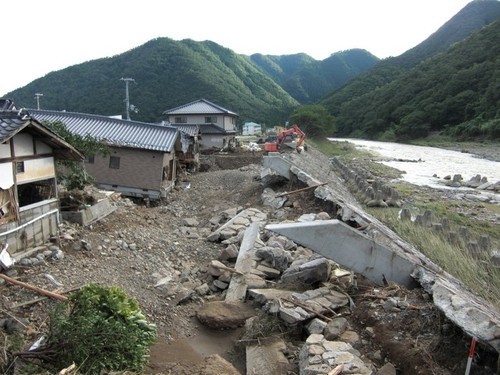
Sean bienvenidos, japonistasarqueológicos a una nueva entrega, en esta ocasión hablaré sobre actualidad nipona, una vez dicho esto pónganse cómodos que empezamos. — El domingo 16 de julio, azotaron fuertes lluvias al archipiélago nipón y hace no mucho el tifón Lan paralizó el tráfico aéreo de Japón y dejó miles de evacuados al oeste, además sin electricidad. Pero en este caso se han anegado muchas zonas del norte, causando efectos geográficos catastróficos y causando evacuaciones, etc. Por ejemplo: La ciudad de Akita registró precipitaciones, fue un récord, más de 250 milímetros durante un período de 48 horas, todo un hito histórico. — Espero que os guste y nos vemos en próximas publicaciones, que pasen una buena semana. - Welcome, Japanese archaeologists, to a new installment, this time I will be talking about Japanese current affairs, and once that is said, make yourselves comfortable and let's get started. - On Sunday 16th July, heavy rains hit the Japanese archipelago and not long ago Typhoon Lan paralysed Japan's air traffic and left thousands of evacuees in the west without electricity. But in this case many areas in the north have been flooded, causing catastrophic geographical effects and causing evacuations, etc. For example: The city of Akita recorded record rainfall of more than 250 millimetres over a 48-hour period, a historic milestone. - I hope you like it and see you in future posts, have a good week. - 日本の考古学者たちよ、新しい回へようこそ。今回は日本の時事問題についてお話しします。そう言ったら、くつろいで、始めましょう。 - 7月16日の日曜日、日本列島は大雨に見舞われ、少し前には台風12号が日本の空の便を麻痺させ、西日本では何千人もの避難者が停電に見舞われた。しかし今回は、北部の多くの地域が浸水し、地理的に壊滅的な影響を引き起こし、避難などを余儀なくされている。例えば:秋田市では、48時間に250ミリ以上の記録的な雨量を記録し、歴史的な出来事となった。 - お気に召していただけたなら幸いである.


Sean bienvenidos, japonistasarqueológicos, a una nueva entrega de religión nipona, una vez dicho esto pónganse cómodos qué empezamos. - Seguramente, todos hemos escuchado hablar del Budismo y Sintoísmo, dos religiones muy diferentes entre sí, ya que sus pilares religiosos no están hechos de la misma materia, voy a intentar resumir este tema para que todos podamos entenderlo mejor. ¿Cuándo llego el budismo a Japón? Llego en el siglo VI d.c en el período kofun también denominado protohistoria, lo que no voy a negar y lo que todos sabemos es que china, India y otros países influenciaron a Japón y eso lo podemos ver todavía a día de hoy. - Pero hace poco vi el uso de la palabra Sincretismo religioso, lo cual, me parece el término de lo menos apropiado, ¿Qué significa sincretismo? Unión, fusión e hibridación, casos más claros, lo podemos ver en Latinoamérica y con Grecia y Roma. Por lo cual el término más apropiado para este caso sería coexistencia o convivencia, además en el periodo meiji hubo una reforma religiosa para separar ambas religiones y convivencia al sintoísmo, religión del estado, a esto se le llama Shinbutsu bunri en hiragana sería:(しんぶつぶんり) ¿Qué opinan ustedes? - Espero que os haya gustado y nos veamos en próximas publicaciones que pasen una buena semana. - Primera foto :santuario Heian Jingu(Kyoto) Segunda foto: Templo Rengeoin( Kyoto) - Welcome, archaeological Japanists, to a new installment of Japanese religion, having said that, make yourself comfortable as we begin. - Surely, we have all heard of Buddhism and Shintoism, two very different religions from each other, since their religious pillars are not made of the same material, I am going to try to summarize this topic so that we can all understand it better. When did Buddhism arrive in Japan? It arrived in the 6th century AD in the Kofun period also called protohistory, which I will not deny and what we all know is that China, India and other countries influenced Japan and we can still see that today. - But I recently saw the use of the word religious syncretism, which seems to me to be the least appropriate term. What does syncretism mean? Union, fusion and hybridization, clearest cases, we can see it in Latin America and with Greece and Rome. Therefore, the most appropriate term for this case would be coexistence or coexistence. In addition, in the Meiji period there was a religious reform to separate both religions and coexistence with Shintoism, the state religion. This is called Shinbutsu bunri in hiragana: (しん ぶつぶんり) What do you think? - I hope you liked it and we'll see you in future posts and have a good week. - First photo: Heian Jingu Shrine (Kyoto) Second photo: Rengeoin Temple (Kyoto) - 考古学者の日本主義者の皆さん、日本の宗教の新しい記事へようこそ。そうは言っても、安心して始めてください。 - 確かに、私たちは皆、仏教と神道という、互いにまったく異なる 2 つの宗教について聞いたことがあるでしょう。それらの宗教的支柱は同じ素材で作られていないため、私たち全員がよりよく理解できるように、このトピックを要約してみようと思います。 仏教はいつ日本に伝わったのでしょうか? それは、原史時代とも呼ばれる古墳時代の西暦 6 世紀に到来しました。私はそれを否定しません。また、中国、インド、その他の国々が日本に影響を与えたことは誰もが知っており、今日でもそれを見ることができます。 - しかし、私は最近、宗教的混合主義という言葉が使われているのを目にしましたが、これは私にとって最も不適切な用語であるように思えます。 結合、融合、ハイブリッド化の最も明確な事例は、ラテンアメリカやギリシャ、ローマで見られます。 したがって、この場合には「共存」または「共生」という言葉が最も適切でしょう。また、明治時代には両宗教を分離し、国教である神道と共存する宗教改革が行われました。これをひらがなで「神仏分理」といいます。ぶつぶんり)どう思いますか? - 気に入っていただければ幸いです。今後の投稿でお会いしましょう。良い一週間をお過ごしください。 - 1枚目の写真:平安神宮(京都) 写真2枚目:蓮華王院(京都)



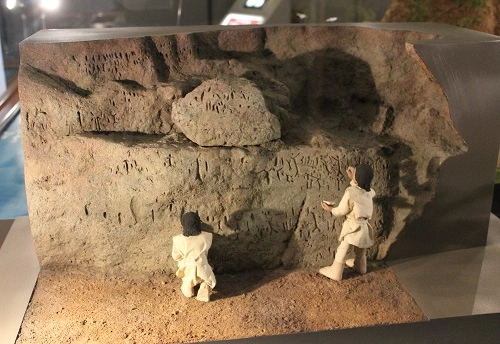

日本の考古学者の皆さん、日本の考古学の新しい記事へようこそ。そうは言っても、気を楽にして始めましょう。 - 1950年代、北海道余市市のフゴッペ洞窟で、縄文時代後期1000年から500年頃の一連の彫刻が発見された。 海水浴のため蘭島を訪れていた札幌市の高校生らが発見した。 これに先立ち、1927年に国鉄函館本線の土塁工事中に9個の彫刻が発見された。 - 洞窟からは動物や魚の骨が多数出土しました。 貝類では二枚貝やカタツムリ、魚類ではヒラメやヒラメなどの沿岸魚からクジラまで、哺乳類ではシカのほか、キツネやタヌキ、オオカミの骨も見つかりました。 - このことからも、当時は食糧が豊富にあり、人々は狩猟や漁業に専念していたことがわかります。 本州で稲作を中心とした弥生文化が発展していた頃、北海道では稲作をする必要はありませんでした。 人を乗せた船の彫刻は北アジアで見られるものと似ていると言われています。 - 気に入っていただければ幸いです。今後の投稿でお会いしましょう。良い一週間をお過ごしください。 - Welcome, Japanesearchaeologicalists, to a new installment of Japanese archaeology. Having said that, make yourself comfortable and let's begin. - In the 1950s, a series of engravings dating from the late Jomon period 1000-500 were discovered in Hokkaido Prefecture in the Fugoppe Cave located in the city of Yoichi. They were discovered by high school students from Sapporo who were visiting Orchid Island to bathe in the sea. Before that, nine carvings were discovered in 1927 during earthworks on the Hakodate main line of the Japanese National Railways. - Many animal and fish bones were excavated in the cave. Shellfish include bivalves and snails, fish range from coastal fish such as flounder and flounder to whales, and mammals include deer, and bones of foxes, raccoon dogs and wolves were also found. - This shows that at that time food was abundant and that people dedicated themselves to hunting and fishing. When the Yayoi culture based on rice cultivation was developing in Honshu, there was no need to grow rice in Hokkaido. The carvings of boats carrying people are said to be similar to those found in northern Asia. - I hope you liked it and we'll see you in future posts and have a good week. - Sean bienvenidos, japonistasarqueológicos, a una nueva entrega de arqueología nipona, una vez dicho esto pónganse cómodos qué empezamos. - En la década de los años 50 se descubrió en la prefectura de Hokkaido en la cueva Fugoppe localizada en la ciudad de Yoichi, se hallaron una serie de grabados que datan del periodo Jomon final 1000-500. Fueron descubiertos por estudiantes de secundaria de Sapporo que visitaban la Isla Orquídea para bañarse en el mar. Antes de eso, se descubrieron nueve tallas en 1927 durante los trabajos de remoción de tierra en la línea principal de Hakodate de los Ferrocarriles Nacionales de Japón. - En la cueva se excavaron muchos huesos de animales y peces. Los mariscos incluyen bivalvos y caracoles, los peces van desde peces costeros como la platija y la platija hasta las ballenas, y los mamíferos incluyen ciervos, y también se encontraron huesos de zorros, perros mapaches y lobos. - Esto demuestra que en aquella época abundaba la comida y que la gente se dedicaba a la caza y la pesca. Cuando la cultura Yayoi basada en el cultivo del arroz se estaba desarrollando en Honshu, no había necesidad de cultivar arroz en Hokkaido. Se dice que las tallas de barcos que transportan personas son similares a las encontradas en el norte de Asia. - Espero que os haya gustado y nos veamos en próximas publicaciones que pasen una buena semana.
El origen de un país y su prehistoria, un paseo por la historia del país del sol naciente. /国の成り立ちと先史、日出ずる国の歴史を歩く。/The origin of a country and its prehistory, a walk through the history of the country of the rising sun.
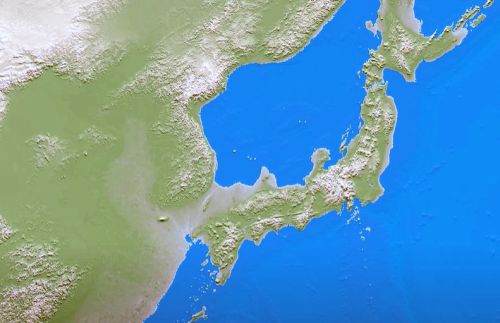



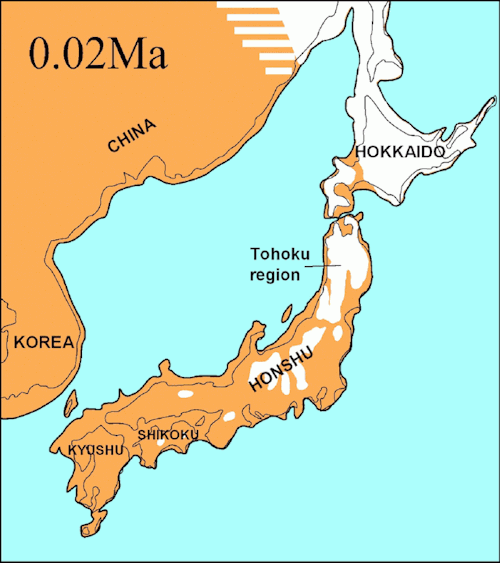

Sean bienvenidos, japonistasarqueológicos, a una nueva entrega de arqueología nipona e historia nipona, una vez dicho esto pónganse cómodos qué empezamos.
-
En los capítulos 1,2,3:Hablamos de: ¿Cuándo llegaron por primera vez los homínidos a Japón? ¿De qué vivían? Hablamos un poco de su geografía, de las cuatro eras glaciales, también se mencionó el holoceno. Empezamos a hablar del pleistoceno, y de cuando empezó la prehistoria de hace 2,5 (esta fecha está desfasada actualmente ronda 4 millones, por los hallazgos de industria lítica) a 7 millones de años. Comentamos algunos homínidos: Homo neanderthalensis, Homo heidelbergensis, homo ergaster entre otros homínidos, comentamos como África es la cuna de la humanidad, y su diversidad de dispersiones migratorias. También se comentó la llegada los homínidos a Okinawa hace 30.000-40.000 años y los Ainus como posibles primeros pobladores. Seguimos hablando del pleistoceno, estuvimos explicando un poco sobre el pleistoceno, se mencionó un poco la formación del archipiélago, mencioné mi posible teoría y al final terminamos con ¿Cómo se llaman las placas tectónicas que forman el archipiélago?
-
Espero que os guste y nos vemos en próximas publicaciones, que pasen una buena semana.
-
日本の考古学者諸君、ようこそ、日本考古学と日本史の新連載へ!さあ、くつろいで、始めよう。
第1章、第2章、第3章では、「ヒト科の動物はいつ日本にやってきたのか?地理、4つの氷河期、完新世についても少し触れました。更新世について話し始め、先史時代が始まった250万年前(この年代は、石器産業の発見により、現在では約400万年古くなっている)から700万年前について話した。ホモ・ネアンデルターレンシス、ホモ・ハイデルベルゲンシス、ホモ・エルガスターなどのホミノイドについて解説し、アフリカが人類発祥の地であること、その移動分散の多様性について述べた。また、3万~4万年前の沖縄へのヒト科動物の到着と、最初の入植者である可能性のあるアイヌ人についても議論した。私たちは更新世について話を続け、列島の形成について少し説明し、私が可能性のある説を述べ、最後にこう締めくくった。 列島を形成しているプレートの名前は?
それではまた、良い一週間を。
-
Welcome, Japanese archaeologists, to a new instalment of Japanese archaeology and Japanese history, so make yourselves comfortable and let's get started.
In chapters 1,2,3:We talk about: When did hominids first arrive in Japan? What did they live on? We talked a little bit about their geography, the four ice ages, the Holocene was also mentioned. We started talking about the Pleistocene, and when prehistory began from 2.5 (this date is now out of date by about 4 million years ago, due to the findings of lithic industry) to 7 million years ago. We commented on some hominids: Homo neanderthalensis, Homo heidelbergensis, homo ergaster among other hominids, we commented on how Africa is the cradle of humanity, and its diversity of migratory dispersions. We also discussed the arrival of hominids in Okinawa 30,000-40,000 years ago and the Ainus as possible first settlers. We continued talking about the Pleistocene, we were explaining a bit about the Pleistocene, the formation of the archipelago was mentioned a bit, I mentioned my possible theory and at the end we finished with What are the names of the tectonic plates that form the archipelago?
I hope you like it and see you in future posts, have a nice week.